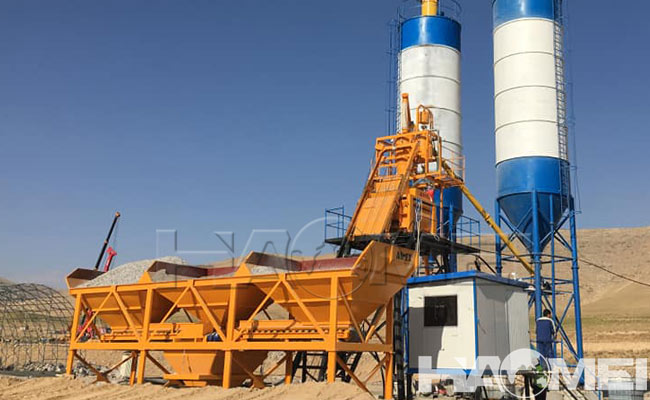Semi Automatic Concrete Batching Plant
A semi automatic concrete batching plant is a type of concrete production equipment that uses semi-automatic control, primarily used for concrete mixing and production in construction projects. Compared to fully automatic concrete batching plants, semi automatic concrete batching plants typically require manual intervention for certain operations, such as raw material feeding, equipment start-up and shutdown.

The main components of a semi automatic concrete batching plant include:
-Mixer:
Used to mix cement, aggregates, water, and other additives. Common types include forced twin shaft concrete mixers and planetary concrete mixers.
- Raw material storage system:
Includes cement silos, aggregate silos, and liquid additive storage tanks.
- Batching system:
Used to weigh and transport different raw materials to the concrete mixer according to the formula.
- Control system:
Usually equipped with a simple control panel, allowing operators to manually operate and monitor the process.
- Conveying system:
Transports the mixed concrete to the construction site. Commonly used systems include belt conveyors and pumping systems.
Semi-automatic concrete mixing plants combine manual operation with mechanical automation, offering significant advantages in cost control, flexibility, and ease of maintenance. Specific advantages include:
1. Significant cost effectiveness:
- Lower purchase cost:
Compared to fully automatic concrete batching plants (which require integrated PLC control systems, high-precision sensors, industrial computers, etc.), semi-automatic equipment omits some intelligent components, typically reducing prices by 30%-50%. For example, a small semi-automatic concrete batching plant (such as HZS25) costs approximately 20,000-30,000 dollars, while a fully automatic concrete batching plant with the same capacity may exceed 50,000 dollars.
- Controllable operating costs:
Manual operation reduces reliance on highly skilled technical personnel; ordinary operators can be trained quickly, resulting in lower labor costs.
2. High operational flexibility:
- Adaptable to diverse needs:
Parameters such as batching ratios and mixing time can be manually adjusted to flexibly meet the production needs of different concrete grades (e.g., C20-C60) or special materials (e.g., fiber-reinforced concrete, lightweight aggregate concrete).
- Controllable production rhythm:
When material supply is unstable or order volume fluctuates, production can be paused/resumed manually, preventing equipment idling or overloading.
3. Convenient maintenance and repair
- Simple structure and fewer failures:
Fewer mechanical parts and a low-complexity electronic control system mean routine maintenance requires only basic operations such as checking belts, lubricating bearings, and cleaning the concrete mixer.
- Low maintenance costs:
Common faults (such as belt misalignment and sensor errors) can be resolved with simple adjustments or replacement of common parts, requiring no professional engineer intervention. Maintenance cycles are short and costs are low.
4. Wide applicability
- Preferred for small projects:
Suitable for projects with a daily concrete demand of less than 50m³, such as rural self-built houses, road repairs, and water conservancy slope protection, avoiding the resource waste of fully automated stations.
- Adaptable to precast component production:
Can meet the intermittent production needs of precast beams, pipe piles, curbs, and other components, enabling multi-variety, small-batch production through manual control.
- Capital constrained user-friendly:
Construction units or individual operators with limited initial investment budgets can quickly enter the market with semi-automatic concrete batching plants, reducing financial pressure.
5. Energy consumption optimization
- On-demand equipment startup:
Core equipment such as the mixing unit and batching machine only operate during production, avoiding the additional energy consumption of a fully automated concrete batching plant due to continuous monitoring and standby.
- Adaptation to low-power configurations:
Optional lower-power motors (e.g., 18.5kW mixing unit) further reduce energy consumption.
6. Manual intervention to compensate for precision shortcomings
- Experience-based calibration improves quality:
Operators can manually adjust concrete properties in real time through visual inspection and slump testing, compensating for potential errors in the semi-automatic metering system (accuracy ±1%-2%).
- Strong emergency response capability:
In case of sensor failure or system malfunction, production can be switched to fully manual mode to continue, avoiding downtime losses.
The semi-automatic concrete batching plant, with its core advantages of "low cost, high flexibility, and easy maintenance," is an ideal choice for small-scale projects, precast component production, and budget-constrained scenarios. It compensates for some automation shortcomings through manual intervention, achieving a balance between cost and efficiency while ensuring basic production needs. If the project scales up or requires extremely high precision, it can be gradually upgraded to fully automated equipment.
Inquiry
| (Please write down the product model or any requirement) | |
| E-mail: | |
| Message: | |
Contact Information
E-mail:chris@concretebatchplant24.com
Tel: +86-371-65621392
Fax:+86-371-86616825
Add : No.14 Waihuan Road,New strict,Zhengzhou,China


